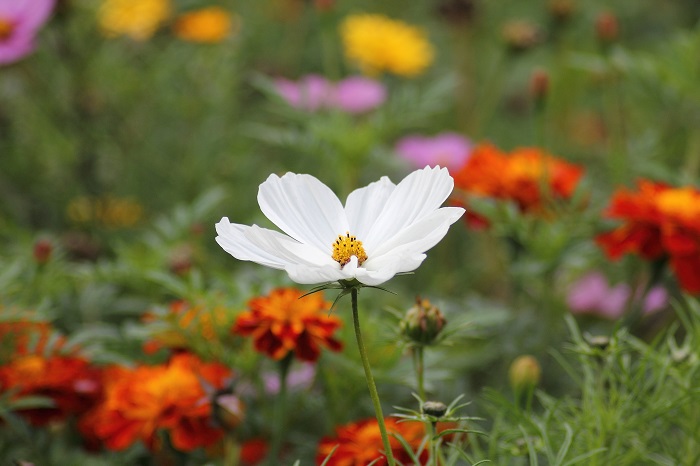Agriculture relies heavily on the health and productivity of the land. While traditional farming practices often prioritize maximizing crop yield, the importance of ground cover, such as wildflowers, is often overlooked. As farmers face mounting challenges such as soil degradation, water scarcity, declining pollinator populations, and the need for sustainable farming methods, integrating wildflowers into agricultural landscapes becomes increasingly vital.
These resilient and adaptable plants offer a range of benefits that extend far beyond their visual appeal. In this article, we will explore the significance of wildflowers as ground cover in an agricultural setting, delving into the practical advantages they provide and offering valuable insights that farmers may need to be aware of.
By embracing wildflowers as integral components of their farming practices, farmers can foster thriving ecosystems, improve soil health, mitigate pest pressures, enhance water management, and strengthen their connection to the surrounding community.
In this article, we embark on a journey to explore the profound significance of wildflowers as ground cover in agricultural settings. Through this exploration, we aim to shed light on wildflowers’ practical advantages while offering invaluable insights that farmers may need to know. By embracing wildflowers as integral components of their farming practices, farmers have the potential to cultivate thriving ecosystems, nurture and improve the health of their soil, effectively manage pest pressures, enhance water management strategies, and fortify their connection to the surrounding community.
By recognizing wildflowers as vital allies in sustainable agriculture, farmers can foster thriving ecosystems within their fields. Wildflowers act as guardians of biodiversity, attracting and supporting many beneficial insects, birds, and pollinators. This symbiotic relationship ensures successful pollination of crops, leading to enhanced yields and increased productivity. Moreover, wildflowers serve as natural pest control agents by attracting predatory insects that feed on harmful pests, reducing dependence on chemical pesticides and promoting ecological balance.
Advantages and benefits of wildflowers in agriculture:
Enhancing Soil Health and Fertility
- Increasing Organic Matter: Wildflowers play a crucial role in building soil organic matter, which improves soil structure, water-holding capacity, and nutrient availability.
- Preventing Erosion: The root systems of wildflowers bind soil particles together, reducing the risk of erosion caused by wind and water.
- Promoting Beneficial Soil Microorganisms: Wildflowers foster a diverse soil microbiome, enhancing nutrient cycling, suppressing harmful pathogens, and promoting plant health.
Supporting Pollinators and Biodiversity
- Attracting Pollinators: Wildflowers act as a magnet for bees, butterflies, and other pollinators, ensuring the successful pollination of crops and enhancing overall yield.
- Natural Pest Control: By attracting beneficial insects, wildflowers help control pests, reducing the reliance on chemical pesticides.
- Preserving Biodiversity: The presence of wildflowers creates habitat diversity, supporting a variety of species beyond the cultivated crops and promoting ecosystem resilience.
Managing Weed Pressure and Competition
- Weed Suppression: Wildflowers can outcompete and suppress the growth of weeds, reducing the need for herbicides and manual weed control.
- Soil Moisture Retention: Wildflowers act as living mulch, shading the soil and reducing evaporation, conserving crop moisture.
- Breaking Disease Cycles: Some wildflowers have allelopathic properties, releasing natural compounds that suppress specific diseases and benefit neighboring crops.
Improving Farm Aesthetics and Community Relations
- Visual Appeal: Wildflower fields provide a visually appealing landscape, adding beauty to the farm and attracting visitors.
- Ecotourism Opportunities: Farms incorporating wildflowers can tap into ecotourism by offering farm tours, workshops, or u-pick experiences, creating additional revenue streams.
- Engaging with the Community: Wildflower fields can serve as educational tools, allowing farmers to connect with their local community and promote sustainable farming practices.
Enhancing Water Management and Conservation
- Water Infiltration: Wildflowers with deep root systems improve water infiltration, allowing rainwater to penetrate the soil more effectively and reduce runoff.
- Water Quality Improvement: Wildflowers act as natural filters, trapping sediments and absorbing excess nutrients from runoff water, improving water quality in nearby water bodies.
- Drought Resilience: Deep-rooted wildflowers are more resilient to drought conditions, enabling them to survive and continue providing ground cover even during water scarcity.
Increasing Genetic Diversity and Adaptability
- Genetic Reservoir: Wildflowers possess a vast array of genetic diversity that can be harnessed to improve crop resilience and adaptability.
- Climate Change Mitigation: By integrating wildflowers into agricultural landscapes, farmers can create more diverse and robust ecosystems capable of withstanding the impacts of climate change.
Enhancing Farm Profitability
- Alternative Revenue Streams: Wildflowers can open up additional revenue streams for farmers by selling seeds and dried flowers or collaborating with local artisans.
- Cost Savings: Incorporating wildflowers can reduce the need for synthetic fertilizers, herbicides, and pesticides, leading to cost savings.
- Market Demand and Brand Differentiation: Highlighting the use of wildflowers and their associated ecological benefits can differentiate farmers’ products in the market and appeal to environmentally conscious consumers.
Conclusion
Incorporating wildflowers as ground cover in agriculture goes beyond mere aesthetics; it offers many practical benefits for farmers. By enhancing water management, increasing genetic diversity and adaptability, improving farm profitability, and promoting ecological sustainability, wildflowers provide valuable contributions to the health and resilience of agricultural systems. Embracing wildflowers as integral components of farming practices can help farmers address various challenges, foster thriving ecosystems, and forge stronger community connections. As we navigate the complexities of a changing world, the importance of wildflowers in agriculture becomes increasingly evident, emphasizing the profound interconnections between agriculture, biodiversity, and the well-being of both people and the planet.
About The Author
Julie and Bob Holland are passionate horticulturists and the founders of Holland Wildflower Farm. With over two decades of experience in the field, they are dedicated to promoting biodiversity and sustainability through the cultivation of native wildflowers. Her blog posts on hollandwildflowerfarm.com offer invaluable insights into landscape techniques, environmental conservation, and the beauty of wildflower ecosystems.

